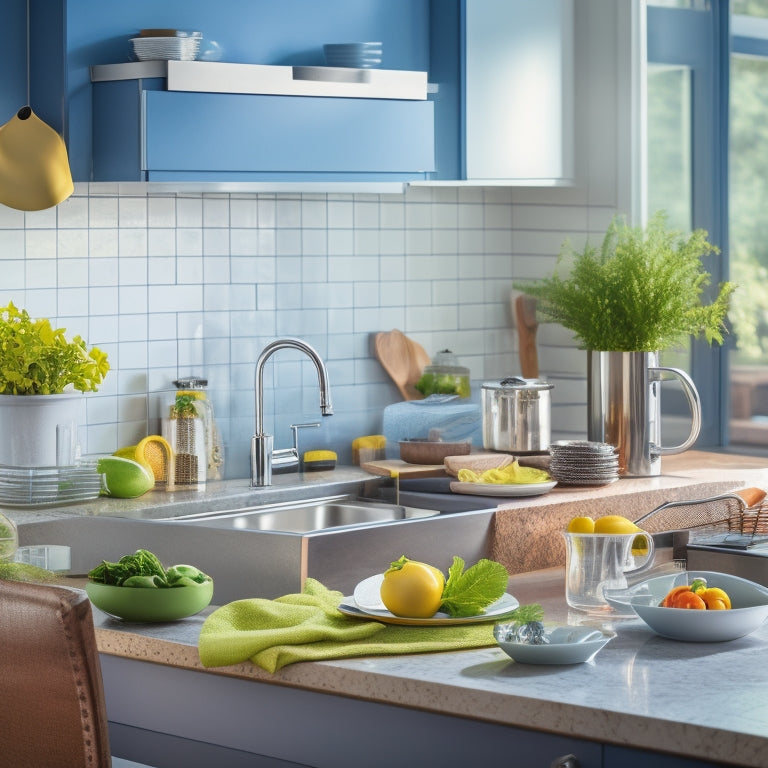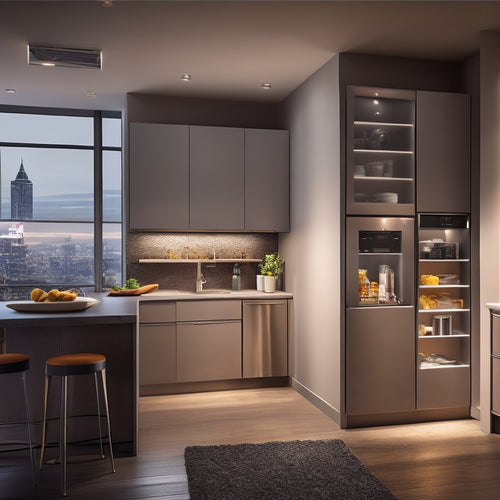
Streamline Your Kitchen: Free Workflow E-Book Inside
Share
You're tired of feeling like your kitchen is working against you. Cluttered countertops, meal prep chaos, and poor time management are stealing your energy and sanity. It's time to take control and streamline your kitchen workflow. Identify the pain points holding you back, map out your ideal kitchen flow, and optimize your zones and stations for maximum efficiency. Learn how to eliminate wasted time and space, and master kitchen storage and inventory hacks. With the right strategies, you can reduce cleaning and maintenance, and put your new workflow into action. Now, discover the secrets to a more efficient, stress-free kitchen.
Key Takeaways
• Identify kitchen workflow challenges, such as cluttered countertops and inefficient task allocation, to prioritize areas for improvement.
• Implement a 'clean as you go' approach and optimize storage space with a pegboard to reduce prep time and increase efficiency.
• Map and visualize kitchen workflow by breaking down tasks into smaller chunks, determining task sequences, and designating specific task areas.
• Organize essential tasks and tools by categorizing, prioritizing, and creating a blueprint for efficiency, and streamline kitchen operations.
• Create a productive routine by simplifying time-consuming tasks, implementing time management strategies, and prioritizing tasks based on goals.
Kitchen Workflow Challenges Exposed
As you navigate your kitchen, you've likely noticed that meal prep, cooking, and cleanup can be a jumbled mess, with cluttered countertops, misplaced utensils, and a general sense of chaos that makes you wonder how you'll get everything done on time.
This disorganization can lead to wasted time, increased stress, and a sense of overwhelm. Effective time management is key to streamlining your kitchen workflow. By prioritizing tasks, allocating specific time slots for meal prep, cooking, and cleanup, you'll be able to tackle each task efficiently.
Implementing efficiency tips such as designating a specific area for utensils, using a 'clean as you go' approach, and optimizing your kitchen layout can also substantially reduce clutter and increase productivity.
Identifying Pain Points and Goals
You're likely familiar with the frustration that comes with a disorganized kitchen, but to truly streamline your kitchen workflow, you need to pinpoint the specific pain points that slow you down and set clear goals for improvement. Take a step back and assess your current kitchen workflow. What tasks take the longest? What areas of your kitchen are the most cluttered? Identifying these pain points will help you focus on the areas that need the most attention.
| Pain Point | Goal | Solution |
|---|---|---|
| Long prep time | Reduce prep time by 30% | Implement a " mise en place" station |
| Cluttered countertops | Clear off countertops | Install a utensil organizer |
| Inefficient storage | Optimize storage space | Invest in a pegboard |
| Difficult meal planning | Plan meals in advance | Create a meal planning calendar |
Mapping Your Kitchen Workflow
Now that you've identified your kitchen's pain points and set goals for improvement, map out your kitchen workflow to visualize how tasks flow and identify opportunities for optimization. This step is essential in streamlining your kitchen, as it helps you pinpoint areas where you can implement time-saving tips and efficiency strategies.
To map your kitchen workflow, consider the following:
-
Identify key tasks: Break down your kitchen tasks into smaller, manageable chunks, such as meal prep, cooking, and cleaning.
-
Determine task sequences: Determine the order in which tasks need to be completed to make sure a smooth workflow.
-
Assign tasks to stations: Designate specific areas of your kitchen for each task to minimize movement and maximize productivity.
- Analyze task overlap: Identify tasks that can be completed simultaneously to save time and increase efficiency.
Essential Tasks and Tools List
Create a detailed list of essential tasks and tools to optimize your kitchen workflow, focusing on must-haves that will simplify meal prep, cooking, and cleaning. This list will serve as your blueprint for streamlining your kitchen operations.
Start by identifying the tasks you perform most frequently, such as chopping, sautéing, and baking. Then, note the tools you need to complete each task efficiently.
Organize your tools into categories, like cooking utensils, baking supplies, and cleaning essentials. This will help you visualize your workflow and pinpoint areas for improvement.
For instance, you might realize you need a stand mixer for efficient baking or a set of sharp knives for quick chopping. By prioritizing your tasks and tools, you'll be able to implement effective organization tips and efficiency strategies that save you time and energy.
With your essential tasks and tools list in hand, you'll be well on your way to a more streamlined kitchen workflow.
Optimizing Kitchen Zones and Stations
By dividing your kitchen into distinct zones and stations, such as a cooking zone, prep zone, and cleaning zone, you can greatly reduce movement and increase productivity during meal prep and cooking. This strategic layout design allows you to focus on specific tasks, streamlining your workflow and saving valuable time.
Here are some organization tips to help you optimize your kitchen zones and stations:
-
Assign a home for each task: Designate a specific area for tasks like food prep, cooking, and cleaning to maintain a clutter-free environment.
-
Group similar tasks together: Place utensils, appliances, and ingredients near their corresponding zones to minimize walking distances and increase efficiency.
-
Utilize vertical space: Maximize your kitchen's vertical space by utilizing wall-mounted shelves, hooks, and baskets to store less frequently used items.
- Keep high-traffic areas clear: Make sure that walkways between zones are obstacle-free, allowing you to move quickly and safely around the kitchen.
Creating a Productive Routine
With your kitchen zones and stations optimized, you're ready to establish a routine that maximizes your efficiency and streamlines meal prep.
To create a productive routine, start by identifying your most time-consuming tasks and focusing on ways to simplify them. Implement time management strategies, such as batching similar tasks together, to reduce handover time and increase productivity.
Next, develop efficiency tips that work for you, like prepping ingredients in advance or using a 'mise en place' system to keep your workspace organized.
Consider your meal prep goals and prioritize tasks accordingly. For example, if you're planning to cook meals for the week, allocate specific times for meal prep, cooking, and cleanup.
Eliminating Wasted Time and Space
You can greatly reduce kitchen chaos by pinpointing areas where time and space are being wasted. By identifying these inefficiencies, you can implement strategies to optimize your kitchen workflow.
Effective time management is essential in the kitchen, where minutes can make all the difference. Take a closer look at your daily kitchen routine and identify tasks that can be streamlined or eliminated.
- Analyze your kitchen layout to identify bottlenecks and areas of congestion.
- Identify tasks that can be delegated or automated, such as prep work or meal planning.
- Consider the 'golden triangle' concept, where your most frequently used items are within easy reach.
- Implement a 'one-touch rule,' where you handle each item only once to minimize unnecessary movement.
Kitchen Storage and Inventory Hacks
Five essential zones can be created in your kitchen to optimize storage and inventory management, ensuring that every item has a designated place and purpose. By doing so, you'll be able to quickly locate what you need, reduce clutter, and make the most of your kitchen's space.
Let's start with pantry organization. Assign categories to specific shelves, such as baking supplies, snacks, or canned goods. Use baskets, bins, and labels to keep similar items together and visible. This will help you identify what you have and what you need to restock.
Next, tackle your fridge by implementing a labeling system. Label each shelf and the contents of each container, so you can easily see what's inside without having to dig through everything. This will help you reduce food waste and make meal planning a breeze.
Reducing Cleaning and Maintenance
Cleaning routines are simplified when every item in your kitchen has a designated home, making it easier to wipe down surfaces and tackle messes as they happen. You'll spend less time searching for misplaced utensils and more time enjoying the fruits of your labor.
By implementing quick organization strategies, you'll be able to:
-
Designate a 'landing strip' near the entrance of your kitchen for keys, mail, and other essentials
-
Assign a specific drawer or shelf for each type of kitchen tool or gadget
-
Utilize vertical storage to maximize your kitchen's real estate
- Implement a 'one-touch rule' for cleaning up spills and crumbs as soon as they happen
This efficient approach to cleaning and maintenance allows you to focus on what really matters – efficient cooking and enjoying quality time with family and friends.
Putting It All Into Action
With your kitchen's new organizational system in place, it's time to put your streamlined space to the test and experience the benefits of a clutter-free cooking environment. You've worked diligently to get to this point, and now it's time to reap the rewards.
To make the most of your new kitchen, focus on effective time management. Prioritize tasks, and allocate specific times for meal prep, cooking, and cleaning. This will help you stay on track and guarantee that everything runs smoothly.
Don't be afraid to delegate tasks to others, such as assigning meal prep duties to family members or roommates. This won't only lighten your load but also encourage teamwork and a sense of responsibility.
As you settle into your new kitchen routine, remember to stay flexible and adapt to changes as needed. Be open to adjusting your schedule or task delegation strategy if something isn't working.
With your new organizational system and effective time management, you'll be able to tackle even the most intricate recipes with ease and confidence.
Frequently Asked Questions
Can I Apply Kitchen Workflow Optimization to a Small Kitchen Space?
You can absolutely optimize your kitchen workflow in a small space by incorporating space-saving solutions, efficiency hacks, and clever organization tips that prioritize functional design, ensuring a seamless cooking experience despite the compact area.
How Do I Handle Kitchen Workflow With Multiple Cooks or Family Members?
"Masterfully manage meal prep and cooking rotation by designating duties, divvying up tasks, and diligently communicating with your kitchen crew, ensuring a seamless workflow that satisfies everyone's culinary cravings."
What if I Have a Non-Traditional Kitchen Layout or Shape?
You're dealing with a non-traditional kitchen layout or shape, aren't you? Don't worry, you'll find corner solutions that maximize space and clever island configurations that adapt to your unique kitchen's needs, creating a seamless workflow.
Can I Use This Process to Optimize My Outdoor Kitchen or BBQ Area?
You can absolutely optimize your outdoor kitchen or BBQ area using this process, perfect for outdoor grilling and BBQ party planning. Assess your space, identify zones, and create a workflow to guarantee seamless entertaining and efficient food preparation.
Are the Workflow Optimization Strategies Suitable for Renters or Temporary Spaces?
Can you really optimize your kitchen without making major changes? Yes, you can! As a renter, you'll love our temporary solutions that won't damage the space. Your renters' kitchen will thrive with our flexible, adaptable workflow optimization strategies.
Related Posts
-

Revolutionize Your Kitchen With Smart Storage Solutions
You're about to reveal the secret to a kitchen that's both stunning and super functional. By incorporating smart stor...
